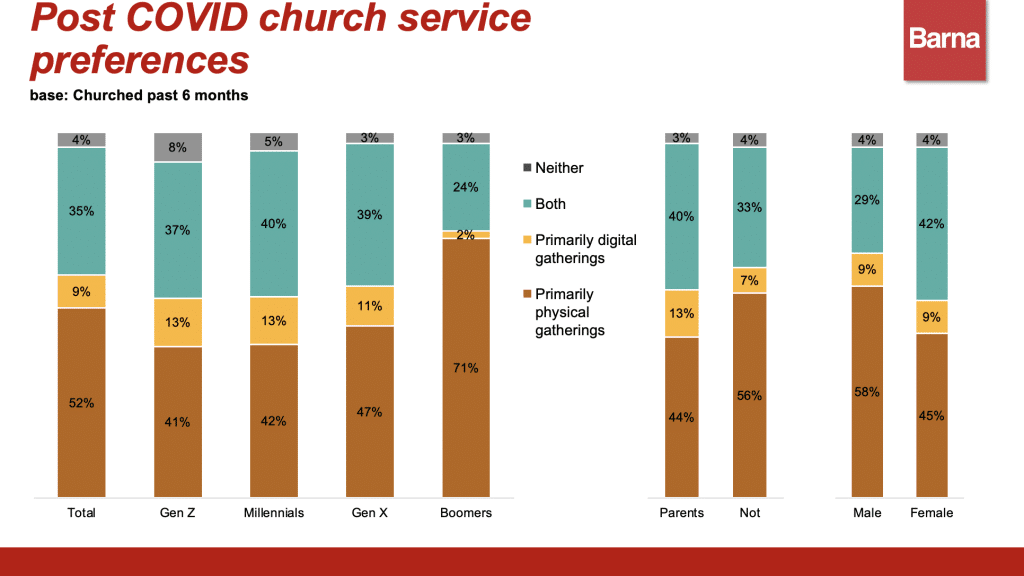
When you’re in the middle of a disruption, it’s hard to know exactly what’s changing, let alone how deeply or permanently things are changing.
As we round the corner into 2022, there are three numbers that, at least for me, show how quickly, radically and perhaps permanently the church is changing.
As you look through these numbers (most from late 2020), you may feel the temptation to explain them, dismiss them or even come up with reasons why the trends don’t apply to you.
I get it. And I empathize.
I’ve heard so many leaders spend the last 18 months saying things like:
People have always gathered in person, and they’ll gather again as soon as possible.
I’m the exception to the rule. I can get people to come back.
This is the CHURCH…in-person gatherings are here forever.
These numbers below paint a different story. One that wise church leaders may want to act on now while there’s still time to pivot.
In this post, I shared 5 reasons the church has left the building and where future church attendance is heading.
Even when the truth isn’t what you want to see, the truth is still your friend.
There are so many numbers floating around right now, but these three in many ways clarify the trends we’re seeing right now. And, as shocking as they are, they can help you prepare for a very different, but also very promising, future. At least that’s my hope.
18 months into a pandemic-shaped world, it’s clear the old ways are waning more than ever.
Even when the truth isn't what you want to see, the truth is still your friend. Click To Tweet1. 36%: In-Person Attendance Isn’t What it used to Be.
In Tony Morgan’s Q3 2020 UnStuck Church Report, he shares that among churches his team surveyed, in-person attendance is 36% of what it was pre-COVID.
No leader entered 2020 saying “I hope we’re at 36% of where we are right now a year from now.” But that’s exactly what happened in 2020.
2021 has only been a little kinder. While numbers vary, The Unstuck Group’s Q2 2021 data showed a drop of 28% for in-person attendance in 2021 over 2020. (Listen here for more on the findings.)
I spoke to one large church pastor recently, who said a year after reopening his in-person attendance was still at 20% of pre-pandemic levels.
And, anecdotally, most churches find themselves hovering between 30-60% of their pre-pandemic. Even the fall of 2021 hasn’t given the churches the boost most pastors longed for.
Even the fall of 2021 hasn't given the churches the boost most pastors longed for. Click To TweetThe Q3 2020 Unstuck Church Report also revealed that only 21% of church leaders agreed that they have a “well-defined digital ministry strategy to engage with people who are outside the church and outside the faith.” In other words, almost 80% don’t.
While I have no current data on that point, my impression talking to church leaders is that as 2021 has motored on, churches have been focused on gathering in person and many haven’t found the time or money to focus deeply in furthering online ministry.
Only 21% church leaders agreed that they have a well-defined digital ministry strategy to engage with people who are outside the church and outside the faith. In other words, almost 80% don't. Click To TweetThere’s a lot of work to do here.
There is evidence a lot of church leaders are stuck right now in the emerging trap of doing nothing well as they straddle both in-person and online ministry. I outline 3 reasons why that’s such a dangerous trap in this post.
So what’s the takeaway?
Most church leaders have the highest levels of staff and budget going to an area where they are seeing the lowest returns. That’s not a sustainable long-term strategy.
Most church leaders have the highest levels of staff and budget going to an area where they are seeing the lowest returns. That's not a sustainable long-term strategy. Click To Tweet2. 41%: The Percentage of Gen Z who primarily prefer physical gatherings post-COVID
So how many people are coming back to in-person gatherings when COVID is over?
Apparently fewer than you think. And fewer than you’d hope.
According to a Barna/Stadia survey done in late 2020, only 41% of Gen Z say that when COVID is over, they want to return to primarily in-person worship. 42% of Millennials say they prefer primarily in-person worship. Which means, of course, that the majority don’t.
41% of Gen Z say that when COVID is over, they want to return to primarily in-person worship. 42% of Millennials say they prefer primarily in-person worship. Which means, of course, that the majority don't. Click To Tweet
It’s easy to think “Well, this is just an unprecedented time. Things will get back to normal soon.”
Maybe, except it’s hard to go back to normal when normal is disappearing.
It's hard to go back to normal when normal is disappearing. Click To TweetThe very low attendance numbers that many church leaders often dismiss as medical (i.e. caused by COVID) may actually be a much deeper cultural and generational shift than we realize.
A further drill down shows that parents are looking at hybrid options (combination of in-person and digital) more seriously than non-parents. And that women are more open to digital church than men.
As strange as this finding seemed a year ago, that trend appears to be bearing out in many churches a year later.
The very low attendance numbers that many church leaders often dismiss as medical (i.e. caused by COVID) may actually be a much deeper cultural and generational shift than we realize. Click To TweetCrisis is an accelerator, and so many of the trends we’ve been seeing over the last few decades have now happened faster than ever, in real-time.
The digital genie is out of the bottle.
Your church is still around. The church is still around. It’s just leaving the building.
Here’s the challenge with not changing: vaccines can’t solve cultural and generational shifts. Innovation will, but vaccines won’t.
The digital genie is out of the bottle. Your church is still around. The church is still around. It's just leaving the building. Click To Tweet3. 30%. The Percentage Point Gap Between Boomers and Gen Z
Have another look at the chart above in point #2. You know who really desires physical gatherings?
Boomers.
71% of Boomers say they want primarily in-person church attendance after COVID is over. For Gen Z, only 41% prefer primarily physical gatherings in the future. That’s a 30 point gap.
71% of Boomers say they want primarily in-person church attendance after COVID is over. For Gen Z, only 41% prefer primarily physical gatherings in the future. That's a 30 point gap. Click To TweetA 30 point gap is a large gap…and here’s how it might be impacting your leadership.
First, the average senior pastor is a Boomer. According to a Barna survey, the average age of the senior pastors in America in 2017 was 54. That’s a four-year-old statistic, which would now push that average age into the late fifties.
Look at the composition of many church boards, senior leadership teams, and key donors (or even volunteers), and you might get some group-think going based around your own personal preferences: doesn’t everybody want to come back to attend in person? According to this research, that’s exactly how older adults would think.
Except it’s not reflective of anyone under age 55.
If you think Gen Z is an anomaly, again, look at the chart. Only a minority of Millennial, Gen Z, and even Gen X want to primarily gather in person in the future.
The changes happening right now in church attendance preferences are not just cultural, they’re generational.
The changes happening right now in church attendance preferences are not just cultural, they're generational. Click To TweetSo what can you do?
First, get some young leaders around your table. Don’t just get them sharing opinions…get them making decisions.
Second, rethink the allocation of resources you’re spending on in-person gatherings versus online ministry. You’ll make your own choices, but most churches are spending less than 10% of their time and budget on the very thing that will probably give them the greatest potential for the future—a strong online presence.
In many ways, this confirms what you already know. Regular church attendance has been dropping for decades. The crisis appears to have accelerated that.
In-person isn’t going away. But it likely won’t play the role it used.
If your mission is to fill buildings, then keep going with your current strategy. But if your mission is to reach people, it might be time to rethink things.
For the full Barna and Stadia report on how the generations are processing this moment and the future, you can go to Barna.com/DigitalChurch and download the “Six Questions About the Future of the Hybrid Church Experience” research journal.
If your mission is to fill buildings, then keep going with your current strategy. But if your mission is to reach people, it might be time to rethink things. Click To Tweet